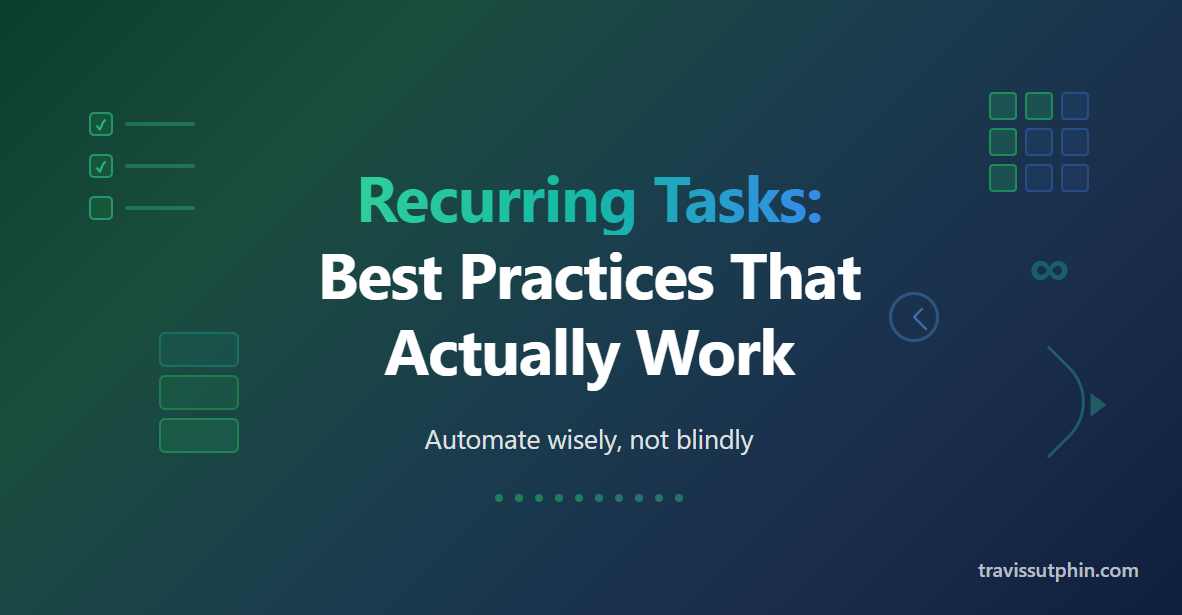Recurring tasks are one of the most underused, and misused features in many project management tools. When done right, they can keep your team on track without extra effort. Done wrong, they create clutter, confusion, and missed work.
Let's walk through the best practices to help you use recurring tasks wisely with real-world project examples to make it clear when to hit "repeat" and when to skip it.
5 Best Practices for When to Use Recurring Tasks
1. For Routine Work
Use recurring tasks for repeating actions like weekly check-ins, daily standups, or monthly invoicing to save time and stay consistent.
Why it's a best practice: Routine work is predictable and happens on a set schedule—think weekly team meetings, daily standups, or monthly client billing. Recurring tasks ensure these never slip through the cracks, especially in fast-paced environments where ad-hoc tasks can take over.
Example: Without a recurring task for invoicing, finance might forget to bill a client one month, impacting cash flow.
2. Reduce Manual Setup
Automates task creation so you don't have to remember or recreate tasks each time, reducing human error.
Why it's a best practice: Manually creating the same task over and over wastes time and increases the risk of inconsistencies (wrong due date, missing assignee, skipped steps). Automating this setup streamlines workflows and frees up mental space.
Example: If you manually recreate a weekly report task and forget to tag the correct team, the report may not get done on time.
3. Ensure Accountability
Keeps team members responsible for ongoing duties with a clear cadence and assigned ownership.
Why it's a best practice: Recurring tasks clearly define who is responsible and when it's due. This eliminates ambiguity, promotes ownership, and keeps the team aligned. If a task is missed, it's easy to identify and follow up.
Example: A recurring "Check website uptime logs" task every Monday ensures the DevOps engineer knows it's their responsibility, every time.
4. Support Long-term Processes
Ideal for maintenance tasks, audits, or performance reviews that need to happen regularly without being forgotten.
Why it's a best practice: Long-term processes often get pushed aside by urgent daily work. Recurring tasks ensure these important but not urgent activities get the attention they deserve.
Example: Monthly security audits might seem less important than daily bug fixes, but missing them for 6 months can lead to serious vulnerabilities.
5. Maintain Consistency
Establishes regular touchpoints for quality control, client communication, and team alignment.
Why it's a best practice: Consistency builds trust with clients and maintains quality standards. When processes happen regularly, they become habits that improve over time.
Example: Weekly client check-ins prevent small issues from becoming project-ending disasters.
5 Situations to Avoid Recurring Tasks
1. One-time Project Deliverables
Don't make "Design homepage mockup" recurring—it's a specific deliverable with a clear end.
2. Variable Timing Tasks
If something happens "when needed" rather than on a schedule, manual creation is better.
3. Context-Heavy Work
Tasks that require significant setup or context each time are better created fresh.
4. Experimental Processes
Don't automate something you're still figuring out—wait until the process is stable.
5. Personal Preferences
If team members prefer to manage certain tasks their own way, don't force automation.
The Bottom Line: Smart Automation
Recurring tasks should feel invisible when they work and obvious when they don't. Use them for predictable, valuable work that keeps your project healthy. Skip them for creative, one-time, or highly variable work.
The test: If you can explain the task, its timing, and its importance in one sentence, it's probably a good candidate for recurring.
Need help optimizing your team's workflows and project management systems?
I've implemented recurring task systems that keep teams on track without the overhead. Let's streamline your processes.



Comments Coming Soon!
We're building a space for builders to share insights.
Start a Conversation →For now, reach out directly with your thoughts!